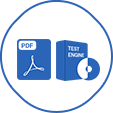Last Update 3 hours ago Total Questions : 264
The PMI Risk Management Professional (PMI-RMP) Exam content is now fully updated, with all current exam questions added 3 hours ago. Deciding to include PMI-RMP practice exam questions in your study plan goes far beyond basic test preparation.
You'll find that our PMI-RMP exam questions frequently feature detailed scenarios and practical problem-solving exercises that directly mirror industry challenges. Engaging with these PMI-RMP sample sets allows you to effectively manage your time and pace yourself, giving you the ability to finish any PMI Risk Management Professional (PMI-RMP) Exam practice test comfortably within the allotted time.
During a project's planning phase, the project team identifies a potential supplier delay and marks it as a significant risk. A risk manager is tasked with effectively monitoring this risk.
What should the risk manager document as the risk trigger?
A new risk manager has been assigned to a delayed strategic project. The risk manager presented a new plan to get the project back on track using lessons learned and applying risk response strategies. Senior management wants to remove contingency reserves because they want to finish the project earlier.
What should the risk manager do in this scenario?
A risk manager is reviewing documentation for a project following a risk planning workshop with project stakeholders and team members. Several items have been identified on the risk log that would be detrimental to project success, but the associated triggers cannot be managed by the organization and are unlikely to occur.
Which response should the risk manager recommend for these risk items?
A major data center initiative involves performing a sensitivity analysis to determine the center's required amount of disaster recovery. Several key stakeholders are in disagreement about which level of disaster recovery is required. The lessons learned disaster recovery plans, and the difference for this data center is its geographical location and unique climate requirements. The database includes examples from previous similar initiatives, as well as the competitor's advertised plans.
What should the risk manager do to quantify the risk?
A project is evaluating a new software to streamline the current purchase order process. The current process is labor-intensive and involves printing, ink signatures, scanning, and emailing. Several team members gathered cycle time data to gauge the current process and evaluate the new process.
What should the risk manager do next with the data set?
A new risk manager has been hired on a project and meets with the project director. The project director supplies the project's risk register and asks the risk manager for an analysis of its effectiveness.
What two actions should the risk manager do next? (Choose two.)
A project team identifies that there is a probability of missing a key milestone in a project. The team wants to move forward with the risk response planning.
What should the risk manager complete first?

